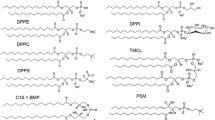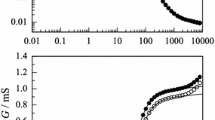Summary
Monoolein lipid bilayers were formed using a monolayer transfer technique and from dispersions of monoolein in squalene, triolein, 1-chlorodecane and 1-bromodecane. Measurements of optical reflectance and electrical capacitance were used to determine the thickness and dielectric constant of the bilayers. The thickness of the hydrocarbon region of the five bilayer systems ranged from 2.5 to 3.0 nm. Two of the bilayer systems (made from 1-chlorodecane and 1-bromodecane solvents) had a high dielectric constant (2.8 to 2.9) whereas the other bilayer systems had dielectric constants close to that of pure hydrocarbons (2.2). The charge-pulse technique was used to study the transport kinetics of three lipophilic ions and two ion carrier complexes in the bilayers. For the low dielectric constant bilayers, the transport of the lipophilic ions tetraphenylborate, tetraphenylarsonium and dipicrylamine was governed mainly by the thickness of the hydrocarbon region of the bilayer whereas the transport of the ion-carrier complexes proline valinomycin-K+ and valinomycin-Rb+ was nearly independent of thickness. This is consistent with previous studies on thicker monoolein bilayers. The transport of lipophilic anions across bilayers with a high dielectric constant was 20 to 50 times greater than expected on the basis of thickness alone. This agrees qualitatively with predictions based on Born charging energy calculations. High dielectric constant bilayers were three times more permeable to the proline valinomycin-K+ complex than were low dielectric constant bilayers but were just as permeable as low dielectric constant bilayers to the valinomycin-Rb+ complex.
Similar content being viewed by others
References
Benz, R., Conti, F. 1981. Structure of the squid axon membrane as derived from charge-pulse relaxation studies in the presence of absorbed lipophilic ions.J. Membrane Biol. 59:91–104
Benz, R., Fröhlich, O., Läuger, P. 1977. Influence of membrane structure on the kinetics of carrier-mediated ion transport through lipid bilayers.Biochim. Biophys. Acta 464:465–481
Benz, R., Fröhlich, O., Läuger, P., Montal, M. 1975. Electrical capacity of black lipid films and of lipid bilayers made from monolayers.Biochim. Biophys. Acta 394:323–334
Benz R., Gisin, B.F. 1978. Influence of membrane structure on ion transport through lipid bilayer membranes.J. Membrane Biol. 40:293–314
Benz, R., Läuger, P. 1976. Kinetic analysis of carrier-mediated ion transport by the charge-pulse technique.J. Membrane Biol. 27:171–191
Benz, R., Läuger, P. 1977. Transport kinetics of dipicrylamine through lipid bilayer membranes. Effects of membrane structure.Biochim. Biophys. Acta 468:245–258
Benz, R., Läuger, P., Janko, K. 1976. Transport kinetics of hydrophobic ions in lipid bilayer membranes. Charge-pulse relaxation studies.Biochim. Biophys. Acta 455:701–720
Benz, R., Nonner, W. 1981. Structure of the axolemma of frog myelinated nerve: Relaxation experiments with a lipophilic probe ion.J. Membrane Biol. 59:127–134
Dilger, J.P. 1981. The thickness of monoolein lipid bilayers as determined from reflectance measurements.Biochim. Biophys. Acta 645:357–363
Dilger, J.P., Fisher, L.R., Haydon, D.A. 1982. A critical comparison of electrical and optical methods for bilayer thickness determination.Chem. Phys. Lipids 30:159–176
Dilger, J., McLaughlin, S. 1979. Proton, transport through membranes induced by weak acids: A study of two substituted benzimidazoles.J. Membrane Biol. 46:359–384
Dilger, J.P., McLaughlin, S.G.A., McIntosh, T.J., Simon, S.A. 1979. The dielectric constant of phospholipid bilayers and the permeability of membranes to ions.Science 206:1196–1198
Fernandez, J.M., Taylor, R.E., Bezanilla, F. 1983. Induced capacitance in the squid giant axon.J. Gen Physiol. 82:331–346
Grell, E., Funck, T., Eggers, F. 1975. Structure and dynamic properties of ion-specific antibiotics.In: Membranes, A Series of Advances. G. Eisenman, editor. Vol. 3, pp. 1–126. Marcel Dekker, New York
Hendry, B.M., Urban, B.W., Haydon, D.A. 1978. The blockage of the electrical conductance in a pore-containing membrane by then-alkanes.Biochim. Biophys. Acta 513:106–116
Hladky, S.B. 1979. The carrier mechanism.Curr. Top. Membr. Transp. 12:53–164
Ketterer, B., Neumcke, B., Läuger, P. 1971. Transport mechanism of hydrophobic ions through lipid bilayer membranes.J. Membrane Biol. 5:225–245
Lapointe, J.Y., Laprade, R. 1982. Kinetics of carrier-mediated ion transport in two types of solvent-free lipid bilayers.Biophys. J. 39:141–150
Montal, M., Mueller, P. 1972. Formation of bimolecular membranes from lipid monolayers and a study of their electrical properties.Proc. Natl. Acad. Sci. USA 69:3561–3566
Needham, D., Haydon, D.A. 1983. Tensions and free energies of formation of “solventless” lipid bilayers. Measurement of high contact angles.Biophys. J. 41:251–257
Parsegian, V.A. 1969. Energy of an ion crossing a low dielectric membrane. Solutions to four relevant electrostatic problems.Nature (London) 221:844–846
Parsegian, V.A. 1975. Ion-membrane interactions as structural forces.Ann. N.Y. Acad. Sci. 264:161–174
Petersen, D.C. 1983. The water permeability of the monoolein/triolein bilayer membrane.Biochim. Biophys. Acta 734:201–209
Pickar, A.D., Benz, R. 1978. Transport of oppositely charged lipophilic probe ions in lipid bilayer membranes having various structures.J. Membrane Biol. 44:353–376
Requena, J., Haydon, D.A. 1975. Van der Waals forces in oilwater systems from the study of thin lipid films. II. The dependence of the van der Waals free energy of thinning on film composition and structure.Proc. R. Soc. London A 347:161–177
Reyes, J., Latorre, R. 1979. Effect of the anesthetics benzylalcohol and chloroform on bilayers made from monolayers.Biophys. J. 28:259–279
Vodyanoy, V., Murphy, R.B. 1982. Solvent-free lipid bimolecular membranes of large surface area.Biochim. Biophys. Acta 687:189–194
Waldbillig, R.C., Szabo, G. 1979. Planar bilayer membranes from pure lipids.Biochim. Biophys. Acta 557:295–305
Walter, A., Gutknecht, J. 1984. Monocarboxylic acid permeation through lipid bilayer membranes.J. Membrane Biol. 77:255–264
White, S.H. 1978. Formation of “solvent-free” black lipid bilayer membranes from GMO dispersed in squalene.Biophys. J. 23:337–347
Author information
Authors and Affiliations
Rights and permissions
About this article
Cite this article
Dilger, J.P., Benz, R. Optical and electrical properties of thin monoolein lipid bilayers. J. Membrain Biol. 85, 181–189 (1985). https://doi.org/10.1007/BF01871270
Received:
Revised:
Issue Date:
DOI: https://doi.org/10.1007/BF01871270




